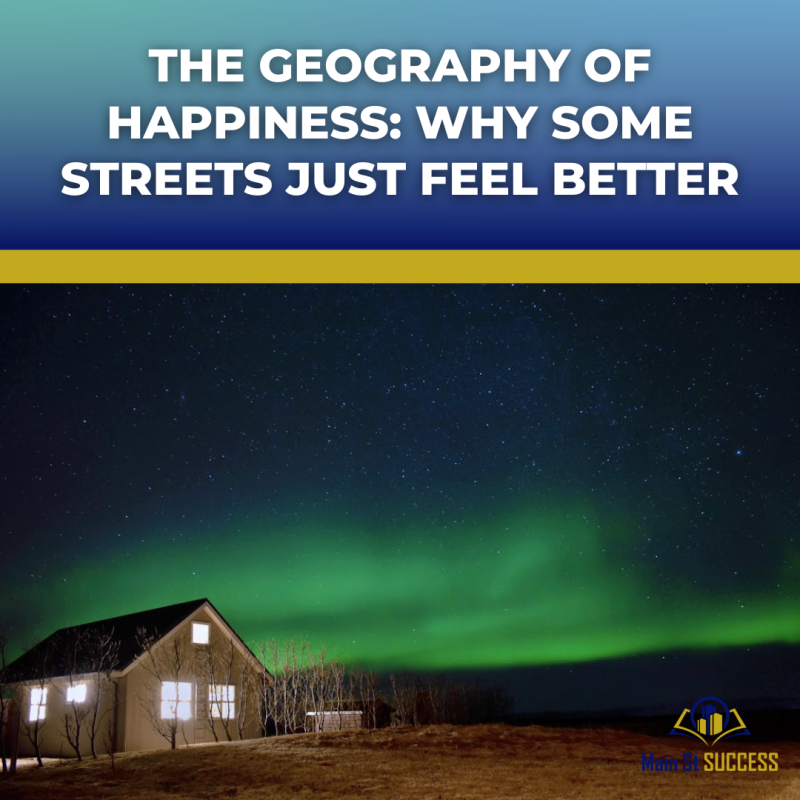Blog
The Geography of Happiness: Why Some Streets Just Feel Better
Every town has that one street people mention with a certain fondness. It is the street where trees arch overhead in summer, where kids ride bikes in the evenings, or where every front porch seems to hold a story. The homes may not be the biggest or newest, but something about the place just feels right.
That feeling is not random. There is a quiet science behind why certain streets make people feel content, safe, and connected. It is part psychology, part design, and part community rhythm. In real estate, understanding that mix is often what separates a pleasant neighborhood from a truly happy one.
The Subtle Power of Street Design
A lot of what makes a street comfortable starts with its physical design. The width of the road, the height of the buildings, and even the speed of traffic can completely change how people experience it.
Wide roads with fast-moving cars can feel exposed or unsafe. Narrower streets, lined with trees or sidewalks, tend to slow things down and bring everything to a more human scale. When the street feels like it is made for people instead of vehicles, neighbors are more likely to walk, wave, and interact.
Urban designers often talk about the sense of enclosure, the feeling of being surrounded just enough to feel protected without feeling boxed in. A good street offers balance, with homes close enough to create warmth but with enough breathing room to allow light and air to move freely. That subtle geometry affects mood more than most people realize.
Trees, Light, and the Comfort of Nature
You cannot talk about a happy street without mentioning trees.
Tree-lined streets not only provide shade and beauty, but they also lower stress levels and even reduce noise. Research shows that people who live on green streets tend to report higher happiness and lower anxiety. The human brain reads natural elements such as leaves, branches, and birds as signs of safety and stability.
Sunlight plays its part too. The direction a street faces changes how light moves through it during the day. Some neighborhoods glow in the morning, while others come alive in the golden light of evening. These rhythms create emotional cues that make a place feel alive and familiar.
In many older neighborhoods, the mix of trees and natural light happened by accident. Today, it is something planners and homebuyers notice deliberately. Whether it is a leafy canopy or a glimpse of open sky, nature anchors a street in calm.
The Role of Scale and Proportion
Proportion is one of those invisible factors you notice only when it feels off. A street where houses sit too close to the road can feel crowded. One where homes sit too far back can feel cold or disconnected. The best streets have a rhythm, with porches at a similar distance, windows that line up in harmony, and fences that create quiet order without feeling rigid.
That rhythm creates harmony you feel before you even think about it. It is the same reason certain town squares or small parks invite people to linger. Humans have a natural sense for balance, and when architecture respects that, it feels right.
For realtors, this awareness becomes practical knowledge. When a buyer says, “I just like this block,” it often has less to do with the house and more to do with proportion, how space and form create a feeling of belonging.
How People Shape the Street
Physical design matters, but people complete the picture. A happy street is rarely perfect-looking. It is alive. You will see chalk drawings on driveways, a few overgrown gardens, and maybe a bench that has been there for years. These signs of human presence make a street warm and interesting.
When neighbors use their front yards and porches, they add to what urban sociologists call eyes on the street. It is not about surveillance, it is about connection. People who see each other daily, even briefly, create unspoken trust. The street becomes a shared space instead of a boundary line between properties.
Community events, yard sales, or even regular walks with dogs help maintain that rhythm of casual contact. Those small interactions, multiplied over time, shape the social comfort of a place more than any new development ever could.
Walkability and the Daily Flow of Life
Walkable streets consistently rank higher in measures of happiness and satisfaction. When you can stroll to a café, park, or grocery store, your world feels more complete. You spend less time isolated in a car and more time naturally crossing paths with others.
Walkability does not depend only on proximity. Sidewalk width, crosswalk safety, and visual interest all play roles. A walkable street invites people to slow down, look around, and participate in the life happening outside their doors.
For many buyers, this is what they mean when they say they want a sense of community. They are not necessarily looking for social events or clubs. They want the kind of neighborhood where daily routines blend naturally with human connection. It is a subtle, lived form of happiness that begins right on the street.
Memory and Emotion in Place
Beyond design and community, there is something deeper at play, and that is memory. Streets that make people happy often carry a sense of continuity. They remind us of places we once knew or moments we have lived. It could be the smell of rain on old pavement, the echo of a basketball bouncing down the block, or the sound of a screen door slamming in summer.
Psychologists call this place attachment. It explains why we can feel connected to a street even if we have only visited a few times. When a place triggers familiar feelings, it feels safe and meaningful.
That is also why some neighborhoods, even new ones, strive to create a sense of timelessness. Sidewalks, front porches, and growing trees help establish a feeling that will endure long after the first owners have moved on. A street that holds memories easily is one that endures.
The Realtor’s Eye for Happiness
Good realtors do not just sell houses. They read the atmosphere of a street. They notice how light hits the front windows, how people park, or how often kids play outside. These quiet observations help match clients with places where they will actually feel at home.
When clients say they have a good feeling about a certain street, it is usually an emotional response to these environmental cues such as proportion, sound, light, and signs of life. Realtors who can explain that connection offer something far more valuable than a transaction. They offer insight into how happiness works in real space.
Why This Matters More Than Ever
As people spend more time at home and think more carefully about their surroundings, the emotional geography of a neighborhood has become as important as its amenities. People are not just asking how many bedrooms there are. They are asking what it feels like to live there.
A beautiful house on an isolating street rarely satisfies for long. But an average home on a warm, inviting block can shape someone’s daily well-being in ways they did not expect.
For communities, that means investing in small but powerful details such as safe sidewalks, shade trees, mixed housing, and public spaces that encourage connection. Those are the roots of happiness that last far beyond property values.
The Streets That Stay With Us
Think back to the happiest streets you have known. Chances are they were not perfect. The pavement might have been cracked and the mailboxes mismatched. But there was something about the rhythm of that place, the laughter, the way sunlight moved through the leaves, and the people who waved, that made it feel alive.
That is the geography of happiness. It is not drawn on maps or captured in listings. It is something you sense as you walk, a feeling of balance, connection, and belonging that turns a street from a stretch of pavement into a place people are proud to call home.

